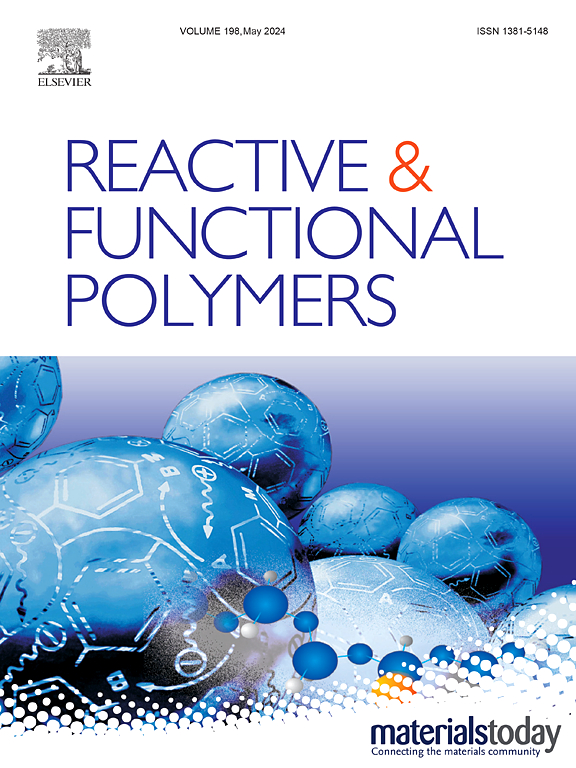可拉伸,可压缩,热响应水凝胶,用于石油管道热工
IF 5.1
3区 工程技术
Q1 CHEMISTRY, APPLIED
引用次数: 0
摘要
水凝胶可以暂时堵塞输油管道,保证热作业的安全。然而,水凝胶在注入过程中容易破碎,化学水凝胶往往难以从输油管道中完全去除。在此,我们通过6-氨基尿嘧啶修饰丙烯酰胺丙烯酸(AUP)与三聚氰胺(MEL)的共聚制备了一种可拉伸、可压缩和热响应的水凝胶。流变学结果表明,水凝胶具有可调节的机械强度和自恢复能力。含25 g/L MEL的水凝胶的最大抗拉强度和伸长率分别为5.19 kPa和237.6%。在3.30 kPa和7.07 kJ/m3下测定了水凝胶的拉伸杨氏模量和韧性。水凝胶的热响应特性表明,由于氢键的存在,水凝胶很容易溶解。水凝胶具有优异的阻燃性能,确保了热工的安全。当水凝胶在模拟管道中的封堵长度达到50 cm时,最大阻力压力为117.3 kPa,具有有效的封堵能力。此外,将水凝胶注入包油管道中,可以置换残余油,显著降低封堵区域的残余油含量,从而进一步保证热作业的安全。堵塞长度为20 cm的水凝胶在70°C热水中大约40分钟内被完全清除。可拉伸、可压缩、热敏的水凝胶可以有效堵塞输油管道,并通过注入热水迅速清除,从而保证了热工的实施,提高了管道维修和更换的效率。本文章由计算机程序翻译,如有差异,请以英文原文为准。

Stretchable, compressible, and thermo-responsive hydrogel for hot work in oil pipelines
Hydrogels can temporarily plug oil pipelines, ensuring the safety of hot work. However, hydrogels are prone to fragmentation during the injection, and the chemical hydrogels are often difficult to completely remove from the oil pipeline. Herein, we prepared a stretchable, compressible, and thermo-responsive hydrogel through the 6-aminouracil-modified copolymerization of acrylamide acrylic acid (AUP) with melamine (MEL). The rheological results indicate the hydrogel exhibits tunable mechanical strength and self-recovery. The maximum tensile strength and elongation of the hydrogel containing 25 g/L MEL are 5.19 kPa and 237.6 %, respectively. Moreover, the tensile Young's modulus and the toughness of the hydrogel are measured at 3.30 kPa and 7.07 kJ/m3, respectively. The thermo-responsive properties of the hydrogel indicate that they can easily dissolve due to the hydrogen bonds. The hydrogel demonstrates exceptional flame-retardant properties, ensuring the safety of hot work. When the plugging length of hydrogel in the simulated pipeline reached 50 cm, the maximum resistance pressure was 117.3 kPa, indicating an effective plugging capability. Furthermore, the hydrogel injected into the oil-coated pipeline can displace the residual oil, significantly reducing the residual oil content in the plugging area, thereby further ensuring the safety of hot work. The hydrogel with a plugging length of 20 cm was completely removed in approximately 40 min with 70 °C hot water. The stretchable, compressible, and thermo-responsive hydrogel can effectively plug oil pipelines and can be rapidly removed by injecting hot water, thereby ensuring the implementation of hot work and enhancing the efficiency of pipeline repair and replacement.
求助全文
通过发布文献求助,成功后即可免费获取论文全文。
去求助
来源期刊

Reactive & Functional Polymers
工程技术-高分子科学
CiteScore
8.90
自引率
5.90%
发文量
259
审稿时长
27 days
期刊介绍:
Reactive & Functional Polymers provides a forum to disseminate original ideas, concepts and developments in the science and technology of polymers with functional groups, which impart specific chemical reactivity or physical, chemical, structural, biological, and pharmacological functionality. The scope covers organic polymers, acting for instance as reagents, catalysts, templates, ion-exchangers, selective sorbents, chelating or antimicrobial agents, drug carriers, sensors, membranes, and hydrogels. This also includes reactive cross-linkable prepolymers and high-performance thermosetting polymers, natural or degradable polymers, conducting polymers, and porous polymers.
Original research articles must contain thorough molecular and material characterization data on synthesis of the above polymers in combination with their applications. Applications include but are not limited to catalysis, water or effluent treatment, separations and recovery, electronics and information storage, energy conversion, encapsulation, or adhesion.
 求助内容:
求助内容: 应助结果提醒方式:
应助结果提醒方式:


